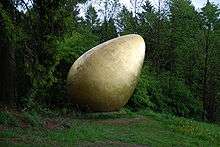Magdalena Jetelová
Magdalena Jetelová (born 1946) is a Czech installation artist and land artist, who has achieved international acclaim. Her work has been exhibited in various prominent galleries internationally such as Museu d'Art Contemporani de Barcelona, Tate Gallery London, Museum of Modern Art, and the Martin-Gropius-Bau. [1]
Magdalena Jetelová | |
|---|---|
| Born | 1946 Semily |
| Nationality | Czech |
| Education | Prague Academy of Fine Arts, Accademia di Belle Arti di Brera |
| Known for | land art |
| Website | http://jetelova.de |

Early life and education
Jetelová was born in Semily, in the former Czechoslovakia. [2] She studied sculpture at the Prague Academy of Fine Arts from 1965–1971, and she briefly studied abroad at the Brera Academy in Milan in 1967 and 1968, under the Italian sculptor Marino Marini.[3][2]
Life
Her early work was significantly influenced by the Prague Spring, often dealing with themes of power and dominance in public spaces. Through the 1980s, she lived and worked in the Tichá Šárka district in Prague, working on pieces exploring social distress and spatial conflict, such as Marking by Red Smoke, Prague.[4][5] She emigrated to West Germany in 1985, and her studio was destroyed.[3] Later works include large-scale wooden sculptures of tables and chairs.[6] Jetelová reproduces and often distorts simple everyday items in large wooden objects in order to explore ideas of regimentation of public space.[4] An exhibit of hers for the Museum Kampa gained attention for floating down the Vltava river due to a flood and ending up near Mělník.[7] Since 1986, she has experimented with outdoor light and laser projection.[8]
Her iconic sculpture Place was installed at the Forest of Dean Sculpture Trail in 1986. It was originally intended to last a short time before being set on fire. Instead the artwork has remained on its hilltop position for 29 years and has been visited by millions of visitors from all over the world. It is due to be decommissioned in 2015.
In her monumental 1992 installation Domestication of the Pyramid, she placed a pyramid made of red quartz sand inside the architecturally ornate Museum of Applied Arts, Vienna.[9] In the next two years it was also installed in Dublin, Martin-Gropius-Bau, Berlin, Rottweil, and Warsaw.[3]

References
- User, Super. "magdalena-jetelova |artists". Cermak Eisenkraft. Retrieved 2020-08-05.
- Glier, Mike (March 14 - April 28, 1987). "PROJECTS: MAGDALENA JETELOVA" (PDF). The Museum of Modern Art. Retrieved 04/08/20. Check date values in:
|access-date=(help) - "Central European Art Database". cead.space. Retrieved 2020-04-03.
- Medea muckt auf : Radikale Künstlerinnen hinter dem Eisernen Vorhang = The Medea insurrection : radical women artists behind the Iron Curtain. Altmann, Susanne,, Lozo, Katarina,, Wagner, Hilke, 1972-, Staatliche Kunstsammlungen Dresden,, Wende Museum (Culver City, Calif.). Köln. 2019. ISBN 978-3-96098-527-3. OCLC 1099843511.CS1 maint: others (link)
- "Magdalena Jetelová". www.jetelova.de. Retrieved 2020-03-01.
- Uta Grosenick; Ilka Becker (2001). Women Artists in the 20th and 21st Century. Taschen. pp. 246–248. ISBN 978-3-8228-5854-7.
- Radio Prague
- Klotz, Heinrich (1997). Contemporary Art: The Collection of the ZKM : Center for Art and Media Karlsruhe. Munich, New York: Prestel. p. 302. ISBN 3-7913-1869-1.
- Women artists in the 20th and 21st century. Grosenick, Uta., Becker, Ilka. Köln: Taschen. 2001. p. 251. ISBN 3-8228-5854-4. OCLC 50185194.CS1 maint: others (link)
| Wikimedia Commons has media related to Magdalena Jetelová. |